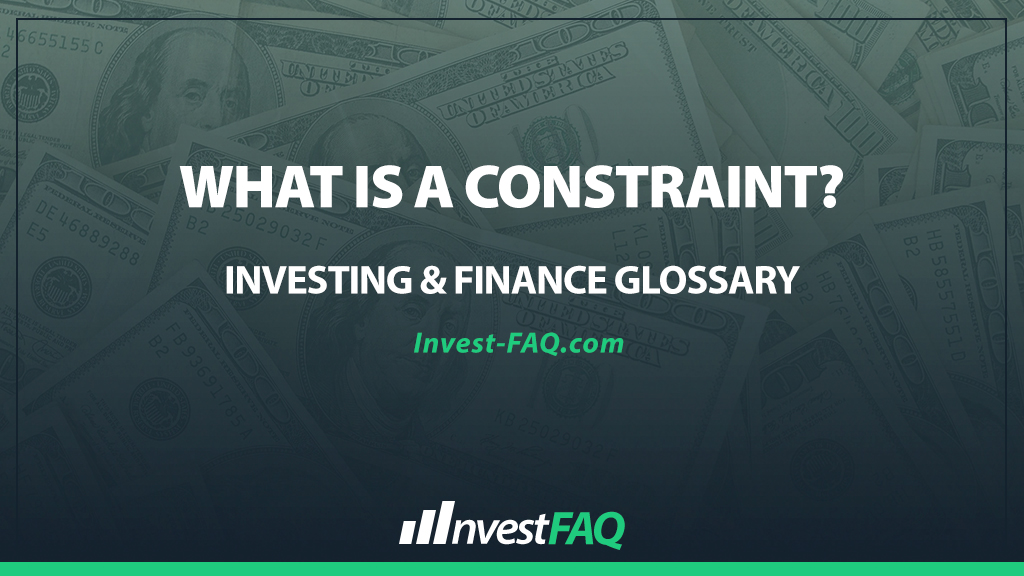
Constraint
Contents
A constraint is any factor that limits the performance, efficiency, or output of a business process or system. It can be a physical limitation, such as capacity issues, or a non-physical limitation, such as policies or market demand, which restricts the system’s ability to achieve higher performance or throughput.
In business, identifying and managing constraints is essential for optimizing operations, improving productivity, and increasing profitability.
The Theory of Constraints (TOC) is a methodology specifically designed to identify the most significant limiting factor (i.e., the constraint) in a production or project management process and systematically improve it.
Example of a Constraint
“QuickPrints LLC,” a commercial printing company, identifies that its printing press is the constraint in its operation. The press can only print 1,000 sheets per hour, while the demand for printing services is higher. As a result, this constraint limits the company’s ability to increase revenue.
Constraint: Printing press with a capacity of 1,000 sheets per hour.
Impact: Limits monthly revenue to $30,000 based on current capacity and demand.
Action: QuickPrints decides to lease an additional printing press to increase capacity.
In this scenario, by identifying the printing press as the primary constraint limiting revenue growth, QuickPrints takes strategic action to mitigate the bottleneck.
The decision to lease an additional press is an investment aimed at overcoming the constraint, allowing the company to meet higher demand and potentially increase its monthly revenue significantly. This example illustrates how identifying and addressing constraints is critical for business growth and efficiency.
Significance for Investing & Finance
The concept of constraints holds significant implications in accounting and financial management:
Cost-Benefit Analysis: Understanding constraints helps businesses conduct cost-benefit analyses to determine the most economically viable solutions for overcoming bottlenecks, supporting strategic investment decisions.
Budgeting and Forecasting: Accounting for constraints in budgeting and forecasting processes ensures that financial plans reflect realistic operational capabilities and market conditions, enhancing the accuracy of financial projections.
Performance Measurement: Identifying constraints is crucial for setting realistic performance targets and evaluating operational efficiency, enabling businesses to focus improvement efforts where they will have the most significant impact.
Resource Allocation: Effective management of constraints often requires reallocating resources — whether it’s capital, labor, or materials — to areas within a business that are most affected by limitations, ensuring optimal use of available resources for maximum return.
In summary, understanding and managing constraints is vital for businesses to optimize operations, improve decision-making, and enhance financial performance.
By focusing on the most significant bottlenecks, companies can allocate resources more effectively, implement targeted improvements, and achieve strategic goals more efficiently, ultimately leading to increased profitability and growth.
FAQ
What is a financial constraint in a business context?
A financial constraint refers to limitations on a company’s resources, such as capital or cash flow, which can restrict its ability to invest in operations, growth opportunities, or new projects.
How does a capacity constraint affect a company’s production process?
A capacity constraint limits the maximum output a company can produce, often due to restrictions in labor, equipment, or raw materials, impacting the firm’s ability to meet customer demand.
What role do budget constraints play in strategic planning?
Budget constraints dictate the financial resources available for strategic initiatives, forcing companies to prioritize projects and make decisions based on the most effective allocation of their limited funds.
In accounting, how is a constraint different from a limitation?
While a constraint refers to a specific restriction on actions or resources affecting financial decisions or processes, a limitation is a broader term that can refer to any factor that restricts a company’s capabilities, including external regulations or market conditions.
